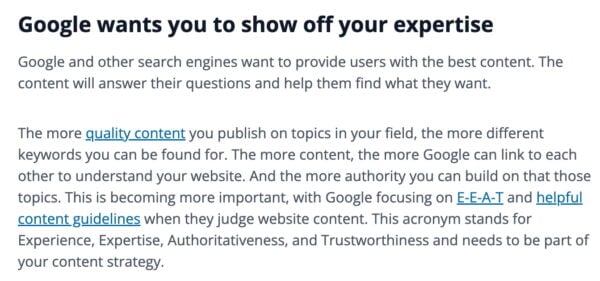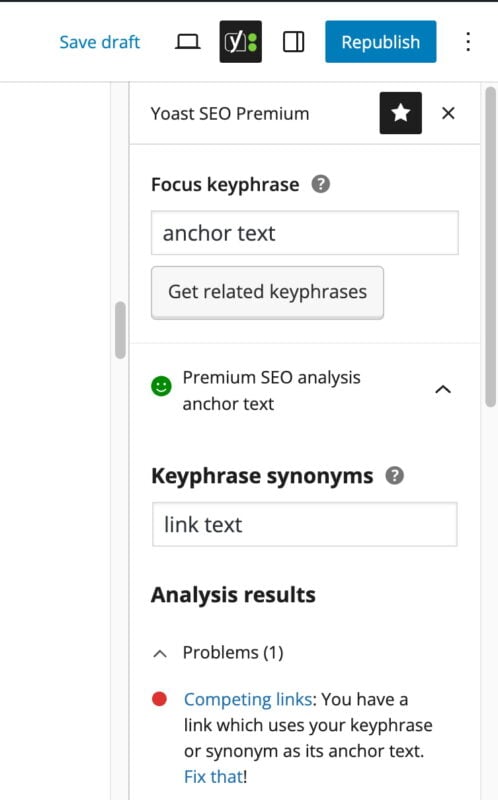What is anchor text, and how can you improve your link texts?

Anchor text, which is also known as link text, is the visible, clickable text of a hyperlink. It usually appears in a different color and is often underlined. Good anchor text tells readers what to expect when they click and gives search engines valuable context about the linked page. Getting your anchor text right helps users navigate your content more easily, improves your internal link structure, and provides search engines with clues about your page relationships, which can positively influence your SEO.
Key takeaways
- Anchor text enhances user navigation and provides context for search engines, improving SEO outcomes.
- Good anchor text clearly describes the linked content and avoids misleading or over-optimized phrases.
- Different types of anchor text exist, each with specific use cases; mix them for variety and clarity.
- Yoast SEO offers tools to analyze competing links and improve anchor text for better search engine ranking.
- To enhance anchor text, ensure it matches the linked content, flows naturally, and clearly signals clickable links.
What does an anchor text look like?
Anchor text is the part of a link that describes the linked page. It guides both readers and search engines toward relevant information. For example, if we link to our post about keyword research tools, the phrase “keyword research tools” is the anchor text.
In HTML, it looks like this:
<a href="https://yoast.com/keyword-research-tools/">keyword research tools</a>The first part is the URL, while the second, the visible text, is the anchor text. Ideally, the words you choose should naturally describe the content on the linked page.
Why are link/anchor texts important?
Links are vital for SEO. They show how your pages connect and help search engines understand your site structure. The anchor text in those links provides extra context.
When Google crawls your site, it uses link text as a clue to what each linked page is about. If multiple links all use the same focus keyphrase, Google might not know which page should rank highest for that topic, leading to competition between your own pages.
That’s why thoughtful, descriptive anchor text matters. It helps search engines interpret your site and helps readers decide whether a link is worth clicking. Over-optimized or misleading link text can confuse both.
Tip: Avoid using your main focus keyphrase in multiple anchor texts within one post, as it can create competing links. Your linking should always feel natural and avoid over-optimization.

Different kinds of anchor text
Anchor text applies to both internal and external links. External sites can link to your content in various ways, and each type sends a different signal to search engines:
- Branded links: Use your brand name as anchor text (e.g., Yoast)
- Naked URLs: Just your site address (e.g., https://yoast.com)
- Site name: Written as Yoast.com
- Article or page title: Matches the title exactly (e.g., What is anchor text?)
- Exact-match keywords: The exact keyphrase of your target page
- Partial-match keywords: A variation that fits naturally in a sentence
- Related keywords: Phrases closely connected to your topic
- Generic links: Words like click here or read more — best avoided!
Ideally, mix your link text types, prioritizing readability and context over repetition.
The competing links check in Yoast SEO
Yoast SEO for WordPress and Yoast SEO for Shopify include a competing links check. This tool analyzes your anchor texts to help you avoid competing links.
If Yoast SEO detects that one of your links contains your focus keyphrase or a synonym of it, then Premium users get a warning. The reason? You don’t want multiple pages trying to rank for the same phrase.
For example, say your focus keyphrase is potato chips. If you link to another page using that exact phrase, Yoast SEO will flag it as a competing link. You’ll see a notification in your SEO analysis, so you can adjust it before publishing. If you have Yoast SEO Premium or Yoast SEO for Shopify, the check will also look for the synonyms of your keyphrase.

How to improve your anchor link texts
If Yoast SEO alerts you about competing links, or if you simply want to improve the quality of your link text, here are some best practices to follow.
1. Create a natural flow
Your writing should feel effortless. If a link feels awkward or forced into a sentence, it probably doesn’t belong there. Always prioritize readability, as a smooth flow improves both engagement and SEO. For more advice on writing content that feels natural while still ranking well, read our SEO copywriting guide.
2. Match the link text to the linked content
Readers should immediately understand what to expect when they click on a link. For example, a link that says meta description should lead to a post explaining what a meta description is and how to optimize it. Clear, logical linking builds trust and helps users navigate your content with ease.
3. Don’t trick your readers
Never mislead readers with inaccurate or confusing link text. If your link text says, “potato chips,” it shouldn’t lead to a page about cars. Consistent and honest linking keeps readers engaged and signals quality to search engines.
4. Make it clear that the link is clickable
Use visual cues such as color contrast or underlining, so it’s easy to tell when text is a link. This not only improves usability but also helps people using assistive technology to navigate your content. To see more on writing accessible, well-structured posts, visit our blogging guide.
5. Bonus tip: put your entire keyphrase in quotes
When using long tail keyphrases, you might see a warning about links that include parts of your focus keyphrase. To avoid this, put your full keyphrase in quotes, for example, “learning how to knit.” This tells Yoast SEO to look for the entire phrase rather than matching individual words.
If you’d like to learn more about writing effective link text and improving your content for SEO, take our SEO copywriting course, which is included with Yoast SEO Premium.
Go Premium and get free access to our SEO courses!
Learn how to write great content for SEO and unlock lots of features with Yoast SEO Premium:
Internal links and anchor texts
Internal links are one of the most effective SEO tools you can use. The Yoast SEO internal linking suggestions tool helps you find and add relevant links throughout your content.
But internal links work best when you write good anchor text for them. Each link should serve a clear purpose and guide readers naturally to related topics. Avoid adding unnecessary or irrelevant links just for the sake of having more connections.
Thoughtful internal linking improves the user experience and helps search engines understand your site’s structure, which is essential for strong SEO performance.
This is anchor text
Anchor text remains a small but powerful element of SEO. It helps users decide whether to click, gives search engines valuable context, and supports a logical site structure.
Keep your anchor text relevant, natural, and transparent and avoid manipulative or over-optimized linking practices. Search engines are now smarter than ever at spotting unnatural links, especially in the era of AI and semantic understanding.
So stay genuine, link with intent, and use Yoast SEO to guide you along the way.
Read more: SEO basics: What is a permalink? »

